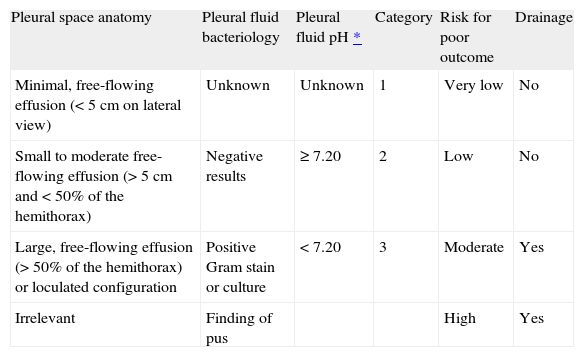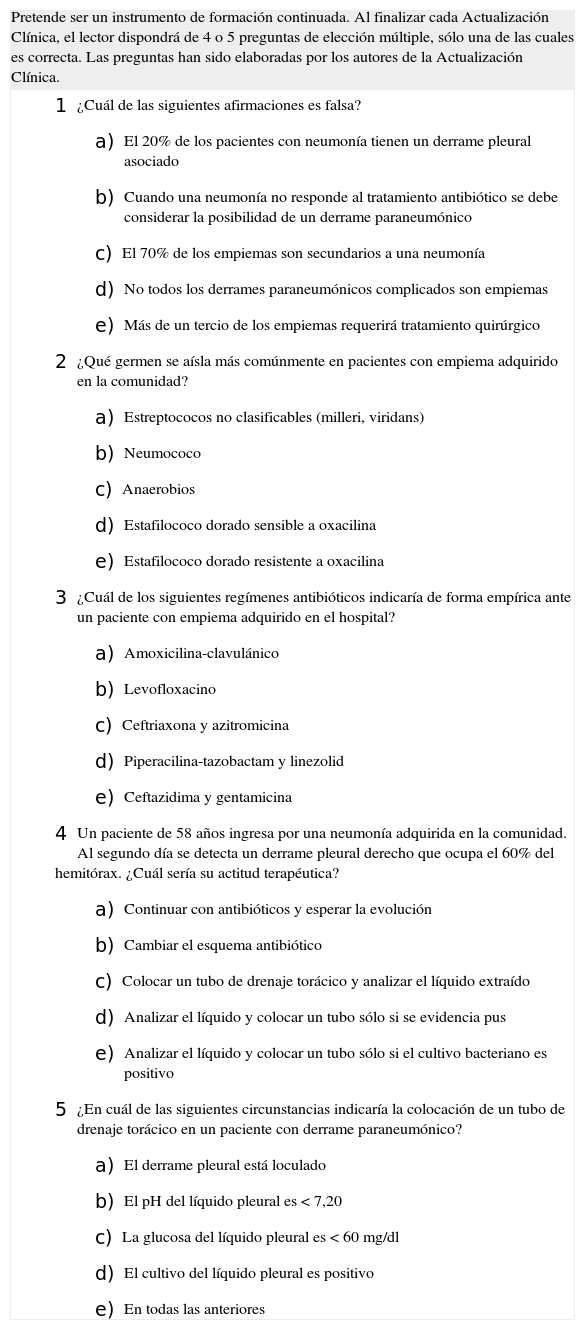About 20% of hospitalized patients with bacterial pneumonia have an accompanying pleural effusion. Parapneumonic effusions (PPE) are associated with a considerable morbidity and mortality. The main decision in managing a patient with a PPE is whether to insert a chest tube (complicated PPE). Imaging (i.e., chest radiograph, ultrasound and computed tomography) and pleural fluid analysis (i.e., pH, glucose, lactate dehydrogenase, bacterial cults) provide essential information for patient management. Therefore, all PPEs should be aspirated for diagnostic purposes. This may require image-guidance if the effusion is small or heavily loculated. According to the current guidelines, any PPE that fulfills at least one of the following criteria should be drained: size ≥ 1/2 of the hemithorax, loculations, pleural fluid pH < 7.20 (or alternatively pleural fluid glucose < 60 mg/dl), positive pleural fluid Gram stain or culture, or purulent appearance. The key components of the treatment of complicated PPE and empyema are the use of appropriate antibiotics, provision of nutritional support, and drainage of the pleural space by one of the following methods: therapeutic thoracentesis, tube thoracostomy, intrapleural fibrinolytics, thoracoscopy with breakdown of adhesions or thoracotomy with decortication. The routine use of intrapleural fibrinolytic therapy remains controversial.
Alrededor del 20% de los pacientes con neumonía bacteriana tienen derrame pleural. Los derrames pleurales paraneumónicos (DPP) se asocian con una considerable morbimortalidad. La principal decisión que debe adoptarse en sujetos con DPP es si se requiere la inserción de un tubo de drenaje (DPP complicado). Las pruebas de imagen (radiografía, ecografía y tomografía computarizada) y el análisis del líquido pleural (pH, glucosa, lactato deshidrogenasa, cultivos bacterianos) ofrecen información muy valiosa. Todos los DPP precisan una toracocentesis diagnóstica que, en ocasiones, debe realizarse bajo control ecográfico si el derrame es pequeño o está loculado. Según las guías actuales, se debe drenar cualquier DPP que cumpla alguna de las siguientes condiciones: tamaño ≥ 1/2 hemotórax, presencia de loculaciones, pH < 7,20 (o glucosa < 60 mg/dl), tinción de gram o cultivo positivo o apariencia purulenta. Las bases del tratamiento del DPP complicado y empiema son el uso de antibióticos apropiados, el soporte nutricional y el drenaje del espacio pleural a través de alguno de los siguientes procedimientos: toracocentesis terapéutica, tubo de toracostomía, fibrinolíticos intrapleurales, toracoscopia con rotura de adherencias o toracotomía con decorticación. El empleo rutinario de fibrinolíticos es controvertido.
Artículo
Diríjase desde aquí a la web de la >>>FESEMI<<< e inicie sesión mediante el formulario que se encuentra en la barra superior, pulsando sobre el candado.

Una vez autentificado, en la misma web de FESEMI, en el menú superior, elija la opción deseada.

>>>FESEMI<<<












